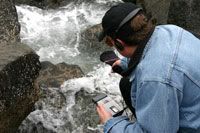Yeah, I know what you're thinking: silly old hippy. But that's only half the story; not only did I want sea noises at the start of one of the tracks, I wanted to record them myself and they had to be taken from the very place that inspired the piece concerned. This meant a trip to Cornwall with some portable recording gear.
So I set off for St Ives with a Sony stereo recording Walkman, a microphone and some headphones. The first couple of days after we arrived there was a stiff breeze and anyone who has ever tried outside recording will know that wind is your worst enemy. This is why news reporters and the like use those microphones that look a bit like stuffed badgers. Their fluffy exterior (the mics', not the reporters') act as a baffle for the wind, meaning that your recording is free from most extraneous weather-produced interference.
I knew all of this, naturally; but I don't have a furry muffle for my mic and, to be honest, I didn't think I'd need one. Sigh.
So the first day that the wind quietened a bit, I went down to the shore with my gear and tried to get some 'lapping' noises on tape. The results were a bit iffy, and I was still getting wind noises (and wet feet) but there were sections of tape that I thought would probably be useable.
Wrong.
It's one thing listening to your efforts on a pair of headphones back at the hacienda, but another one entirely when the results are played back in the discriminating environment of a recording studio. In short, there was too much tape hiss (yes, I wasn't geared up for digital, either) and not enough clear 'lapping' to show through the quiet acoustic intro to the track.
Back to the drawing board – and, as it turned out, back to St Ives. But this time I was prepared. Well, almost. I managed to borrow a Mini Disc recorder from the recording engineer (Martin Holmes) knowing that this would rule out the tape hiss, but was trusting luck that my stereo mic would be good enough to pick up some uninterrupted sea noises.
This time, the weather was more favourable in St Ives; but I was still picking up the wind on the mic. I had to think and, drawing upon survival instincts I didn't know I had, came up with the solution. I got hold of a potato-masher from the kitchen where we were staying, an old sock and a rubber band. By managing to suspend the mic inside the potato-masher with the rubber band and covering the whole assembly with the sock I had a makeshift baffle – and to my surprise (and that of the recording engineer when I played him the results later) it worked. I managed to get about 30 minutes of sea noises from about three different locations and no wind noise.
Recording the sea – improvised mic assemblage in my right hand
We ended up using about 20 seconds of the recording on the album and yes, I know I could have got exactly the same noises from using a library sound-effect disc, but the devil is in the detail and now, whenever I listen to the beginning of 'Dark Harbour' I know that the sea noises came from the exact geographic location where the piece was conceived.

No comments:
Post a Comment